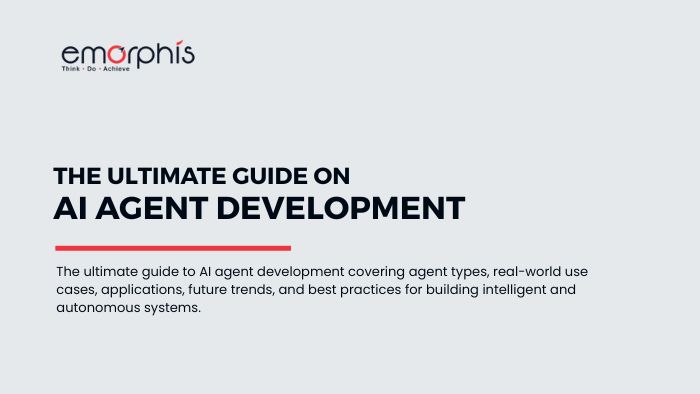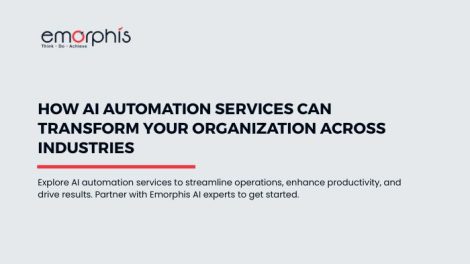Overview
In an era where automation meets intelligence, AI agent development is rapidly redefining how businesses and systems operate. From intelligent personal assistants to autonomous enterprise solutions, AI agents are taking center stage in the AI revolution. This comprehensive guide explores everything you need to know about AI agent development, including technologies, use cases, methodologies, tools, and trends shaping the future of autonomous agents.

According to a report on Grand View Research, the global AI agents market, driven by AI agent development, was valued at USD 5.40 billion in 2024 and is projected to reach USD 7.60 billion in 2025, with exponential growth expected to reach nearly USD 50.31 billion by 2030, reflecting a robust compound annual growth rate of 45.8%.
This surge is driven by heightened demand for automation, advancements in natural language processing, and the growing need for personalized customer engagement. Machine learning technologies lead the market, accounting for over 30% of revenue, while deep learning is the fastest-growing segment.
Deployment patterns favor single-agent systems, though multi-agent systems are gaining rapid traction due to their superior collaboration capabilities. Among agent types, ready-to-deploy solutions dominate current usage, although custom “build-your-own” agents are growing fastest as organizations seek tailored integrations. Build an AI Agent now, connect with an AI Development Company.

Customer service and virtual assistants remain the primary application area, with healthcare poised as the fastest-expanding sector. Regionally, North America leads with a share of ~40%, while the Asia–Pacific region exhibits the highest growth potential.
What are AI Agents?
AI agents are applications that can perceive their environment, make decisions, and act toward achieving specific goals. AI agent development refers to the design, programming, and deployment of these autonomous systems. These agents can range from simple rule-based bots to highly intelligent, LLM-powered agents capable of real-time decision-making and self-improvement.
At its core, AI agent development aims to build intelligent systems that can operate with minimal human intervention, mimicking cognitive functions such as reasoning, planning, and learning. These intelligent agents are built using technologies like:
- Large Language Models (LLMs) like GPT-4, Claude, Gemini
- Reinforcement Learning
- Multi-agent systems
- Natural Language Processing (NLP)
- Decision engines and symbolic reasoning
Why AI Agent Development Matters and Why Your Business Needs One Immediately?
Today, AI agent development is reshaping how organizations operate by introducing intelligent, autonomous systems that can think, learn, and act independently. These agents go beyond traditional automation by understanding context, adapting to new data, and making decisions that align with predefined goals.
From enhancing operational efficiency to improving customer experiences and enabling real-time decision-making, AI agents bring unmatched agility and intelligence to businesses. As technologies like large language models, reinforcement learning, and agentic frameworks mature, the potential of AI agents continues to grow, making them central to the future of digital transformation.
Some of them can be listed as follows:
- Autonomous Decision-Making: AI agents reduce human workload by handling routine and complex tasks.
- Scalability: Once deployed, AI agents can perform at scale across industries like healthcare, finance, and customer service.
- Real-Time Adaptation: Modern AI agents are capable of learning from new data and adapting to changing environments.
- Cost Efficiency: Organizations that invest in AI agent development experience long-term ROI through automation.
In today’s hyper-competitive environment, delayed adoption of AI agent development could leave your business behind. AI agents can handle repetitive tasks, manage workflows, respond to customer queries, and analyze vast datasets, all at scale and with minimal human intervention.
Build an AI Agent now, connect with an AI Development Company.
They help cut costs, boost productivity, and unlock new capabilities that were previously time- or resource-prohibitive. By integrating AI agents now, your business gains a strategic edge, becoming more responsive, data-driven, and resilient. The sooner you deploy, the faster you build a foundation for intelligent, scalable growth.
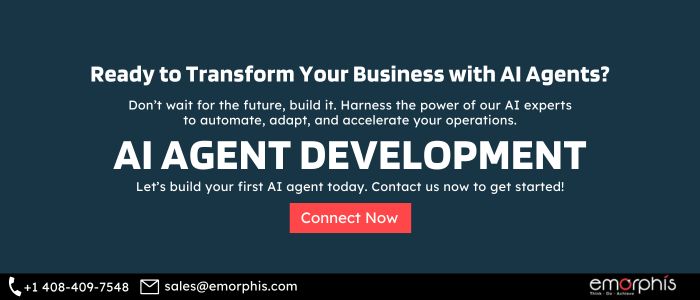
Follow the link to read details on why you need a custom AI chatbot.
Key Components of AI Agent Development
Successful AI agent development involves multiple layers of architecture and functionality. Below are the critical components to understand:
1. Perception Module
AI agents require sensory input, whether it’s text, image, speech, or structured data. Tools like computer vision APIs or NLP engines help agents perceive their environment.
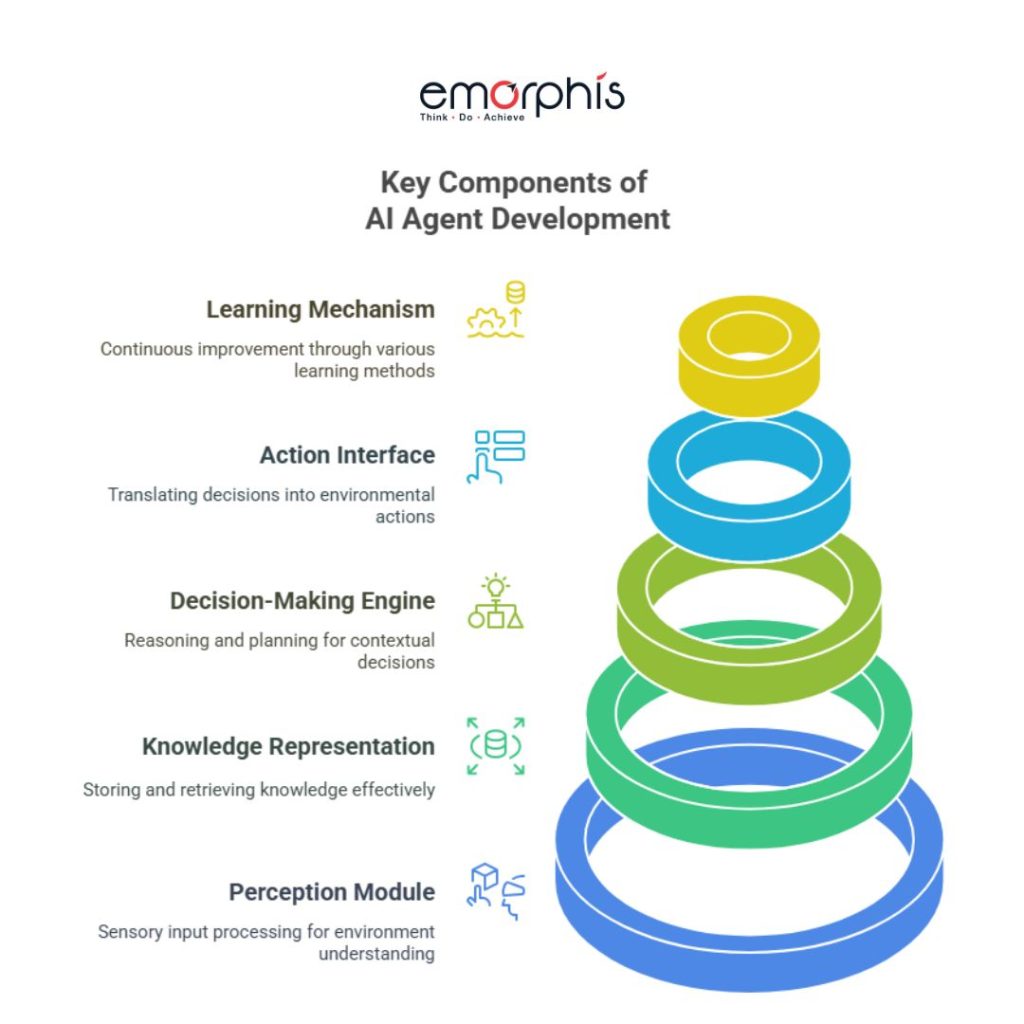
2. Knowledge Representation
An essential part of AI agent development is how knowledge is stored and retrieved. Agents use semantic graphs, vector databases, and ontologies to model knowledge.
3. Decision-Making Engine
This is the brain of the agent. It involves reasoning algorithms, planning, and utility-based decision systems. Modern agents often use LLM-based agents for contextual decision-making.
4. Action Interface
Agents interact with the environment via APIs, robotic arms, software integrations, or chat UIs. The action module is where decisions are turned into outcomes.
5. Learning Mechanism
Continuous learning via reinforcement learning, supervised training, or online learning keeps the agent improving over time.
Types of AI Agents
As you dive deeper into AI agent development, it’s crucial to understand the variety of agents that can be built. Each type of AI agent has a specific behavior model, ranging from simple reflex-driven agents to complex learning systems that evolve over time. Understanding these distinctions helps developers choose the right architecture and capabilities for their specific use case in AI agent development.
1. Reactive Agents
These are the most basic types of agents in AI agent development. Reactive agents operate solely based on current input from the environment without any memory or internal state. They follow predefined rules to respond to stimuli instantly. For example, a motion-detecting security system that turns on a light when it senses movement is a classic reactive agent. While they are fast and simple, they cannot learn or reason.
2. Deliberative Agents
In contrast to reactive agents, deliberative agents are built on symbolic reasoning and internal models of the world. These agents use planning algorithms to map out possible future states and choose actions that will lead to desirable outcomes. Deliberative agents play a major role in goal-directed AI agent development, especially in domains like robotics or autonomous navigation, where environmental modeling and foresight are essential.
3. Goal-Based Agents
These agents are a step further in complexity. Rather than reacting or simply following a model, goal-based agents are designed to achieve specific, pre-defined objectives. They constantly evaluate possible actions based on how effectively each action moves them closer to their goal. In AI agent development, goal-based agents are used in applications like virtual personal assistants, logistics planning, or autonomous vehicles that must reach a destination efficiently.
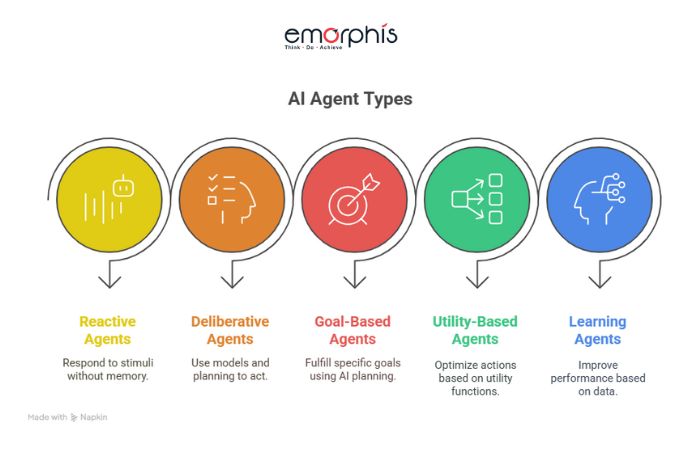
4. Utility-Based Agents
These agents refine the goal-based approach by considering the best possible outcome from a range of actions. They not only work toward a goal but also weigh various factors to determine the most “valuable” path, optimizing for performance, efficiency, or user satisfaction. Utility-based agents are often used in AI agent development for recommendation systems, trading bots, or dynamic pricing engines, where multiple trade-offs must be balanced.
5. Learning Agents
These are among the most advanced forms of agents in AI agent development. Learning agents can observe their environment, evaluate their past decisions, and improve their behavior over time using machine learning techniques. They are capable of adapting to new conditions without explicit reprogramming. Learning agents are central to applications involving customer personalization, predictive analytics, or autonomous experimentation. This type of agent ensures that systems become smarter and more effective the longer they are used.
Each of these agent types serves a specific purpose in the broader ecosystem of AI agent development. Often, complex systems combine multiple types to leverage the strengths of each. For instance, a healthcare diagnostic agent might use reactive components for alerts, deliberative logic for decision trees, and learning capabilities to adapt to new research. Selecting the right type of agent is foundational for building scalable, efficient, and intelligent solutions.
Popular Use Cases of AI Agent Development
The real-world impact of AI agent development is best illustrated through its wide range of applications across industries. By designing autonomous, intelligent agents that can perceive, decide, and act, organizations are redefining efficiency, accuracy, and user experience. From healthcare to logistics, AI agent development is unlocking new capabilities and transforming traditional workflows.
Here are some of the most significant and transformative use cases across various domains:
A. Healthcare
In the healthcare industry, AI agent development is driving the creation of intelligent assistants that improve patient care, support clinical staff, and enhance administrative efficiency. These agents are capable of analyzing complex medical data, assisting in diagnostics, and providing continuous patient monitoring.
Use cases include:
- Virtual Health Assistants: AI agents interact with patients through chat or voice, helping with appointment scheduling, answering symptom-related questions, and delivering medication reminders.
- Clinical Decision Support Systems: Deliberative AI agents analyze patient data, lab reports, and historical cases to assist doctors in diagnosing conditions and suggesting treatment options.
- Remote Patient Monitoring: Learning agents track patients’ vital signs in real time and trigger alerts or emergency responses when anomalies are detected.
- Workflow Automation: Agents handle administrative tasks such as insurance verification, medical transcription, and patient record updates, allowing human staff to focus on critical care.
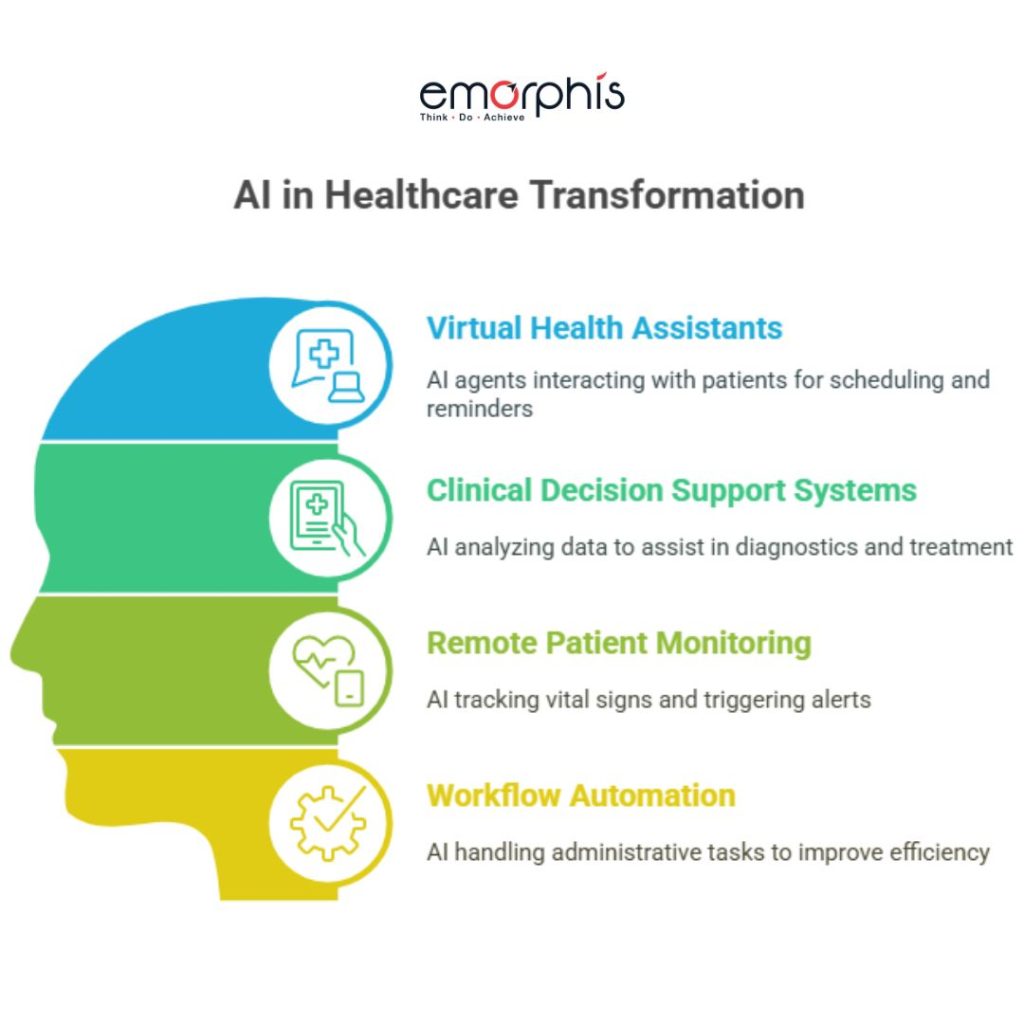
AI agent development in healthcare reduces operational burden while improving diagnostic accuracy and personalized patient experiences.
B. Finance and Banking
The financial sector is leveraging AI agent development to streamline services, improve fraud detection, and personalize customer interactions. Given the volume and complexity of financial transactions, intelligent agents play a crucial role in decision-making and risk management.
Use cases include:
- Robo-Advisors: Utility-based agents assess user profiles, market trends, and risk tolerance to offer personalized investment advice or automatically rebalance portfolios.
- Fraud Detection Agents: Reactive and learning agents analyze transaction patterns to detect suspicious activity in real time, reducing financial losses.
- Automated Customer Service: Chatbots powered by LLM-based agents handle customer queries, provide account details, and resolve disputes with contextual understanding.
- Credit Scoring Agents: AI agents assess creditworthiness by analyzing not just credit history but also alternative data sources such as transaction behavior and social signals.
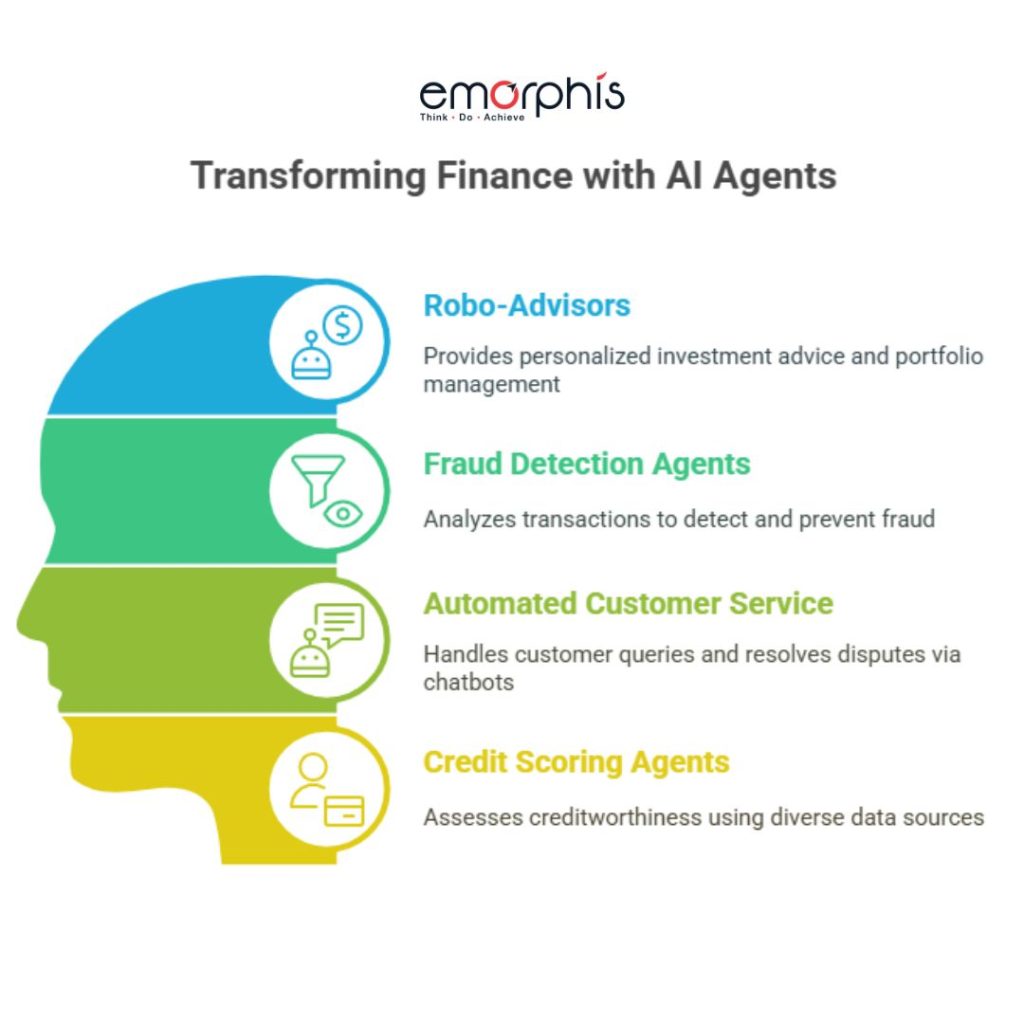
With AI agent development, financial institutions can deliver faster, more accurate, and secure services while minimizing manual effort and risk.
C. E-Commerce and Retail
E-commerce platforms are using AI agent development to create smarter shopping experiences, optimize inventory, and improve customer retention. These intelligent agents provide real-time personalization and operational efficiency at scale.
Use cases include:
- Personalized Shopping Assistants: AI agents recommend products based on browsing history, purchase behavior, and contextual inputs, enhancing user satisfaction and conversion rates.
- Customer Support Automation: Intelligent agents handle order tracking, returns, refunds, and product inquiries around the clock.
- Inventory and Demand Forecasting: Predictive agents analyze sales data, trends, and external factors to anticipate stock requirements and reduce overstock or understock situations.
- Dynamic Pricing Agents: Utility-based agents adjust product prices in real-time based on demand, competition, and inventory levels to maximize revenue.
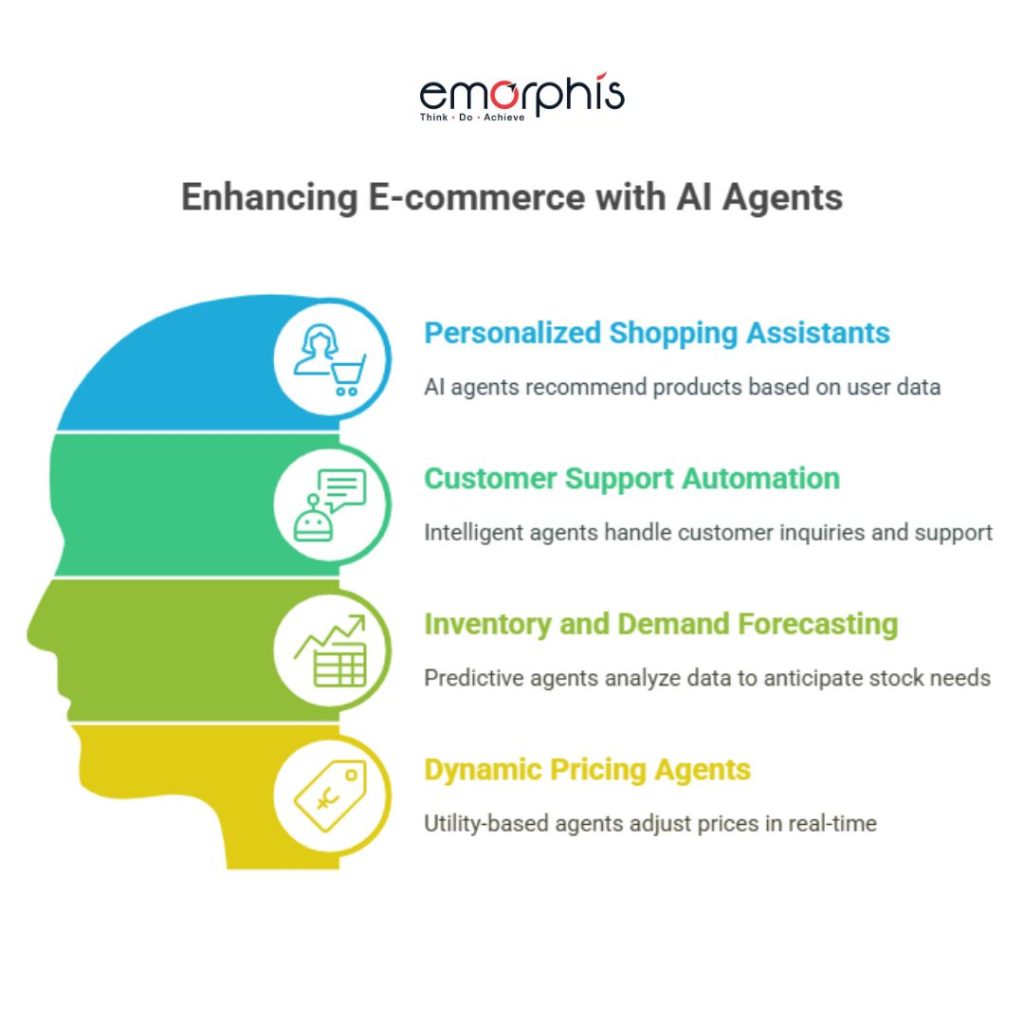
By integrating AI agent development into their ecosystems, retailers can build deeply personalized, scalable, and cost-effective operations.
D. Manufacturing and Industry 4.0
In smart manufacturing, AI agent development contributes to predictive maintenance, supply chain optimization, and production automation. Intelligent agents can interact with industrial IoT devices and systems to enable autonomous decision-making.
Use cases include:
- Predictive Maintenance Agents: AI agents monitor equipment performance data to detect potential failures before they occur, minimizing downtime and repair costs.
- Production Line Optimization: Agents dynamically adjust machine operations based on real-time inputs to ensure quality and efficiency.
- Quality Inspection Bots: Computer vision-enabled agents inspect products for defects using high-speed image analysis and AI models.
- Supply Chain Agents: These agents forecast raw material requirements, coordinate with suppliers, and optimize delivery routes using real-time data and analytics.
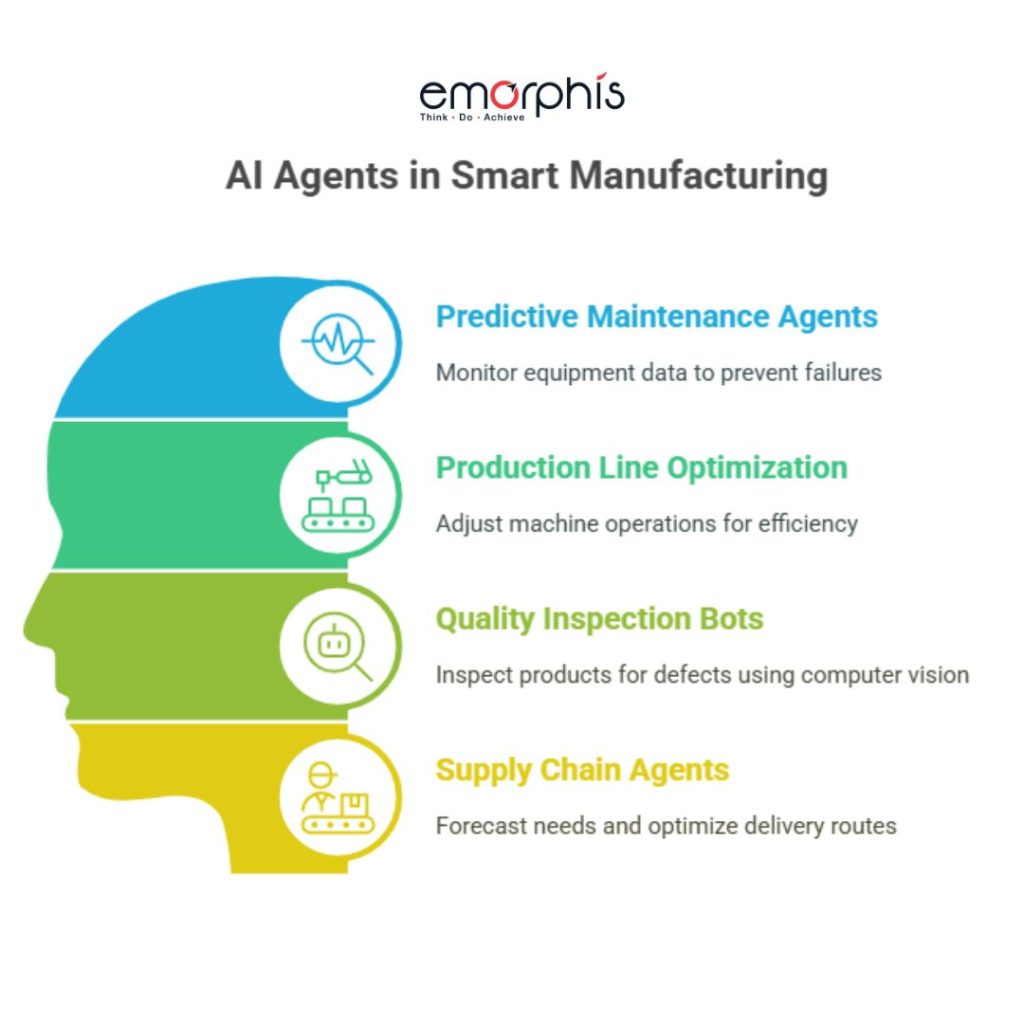
AI agent development allows industries to transition to fully autonomous operations with minimal human intervention, resulting in cost savings and productivity gains.
E. Education and e-Learning
Education is being revolutionized by AI agent development, especially with the integration of adaptive learning and intelligent tutoring systems. These agents provide personalized learning paths and real-time feedback to learners of all ages.
Use cases include:
- AI Tutors: Learning agents assess student performance and tailor content, exercises, and explanations to the learner’s pace and comprehension level.
- Curriculum Planners: Goal-based agents help educators design personalized course paths based on student goals, strengths, and weaknesses.
- Student Support Agents: Available 24/7, these agents can answer common queries, schedule sessions, and recommend resources based on academic progress.
- Assessment Assistants: AI agents evaluate written or oral responses and provide instant feedback, reducing the burden on instructors.

AI agent development in education supports scalable, engaging, and inclusive learning environments.
F. Logistics and Transportation
With rising complexities in global logistics, AI agent development is enhancing route optimization, warehouse automation, and real-time tracking capabilities.
Use cases include:
- Autonomous Fleet Management: AI agents coordinate delivery schedules, route planning, and fuel optimization for transportation fleets.
- Warehouse Robots: Reactive and learning agents navigate and manage inventory storage and retrieval operations.
- Delivery Scheduling Agents: These agents optimize delivery time slots based on real-time traffic, weather, and recipient availability.
- Predictive Supply Chain Agents: Agents forecast demand and adjust supply routes accordingly, reducing delays and costs.
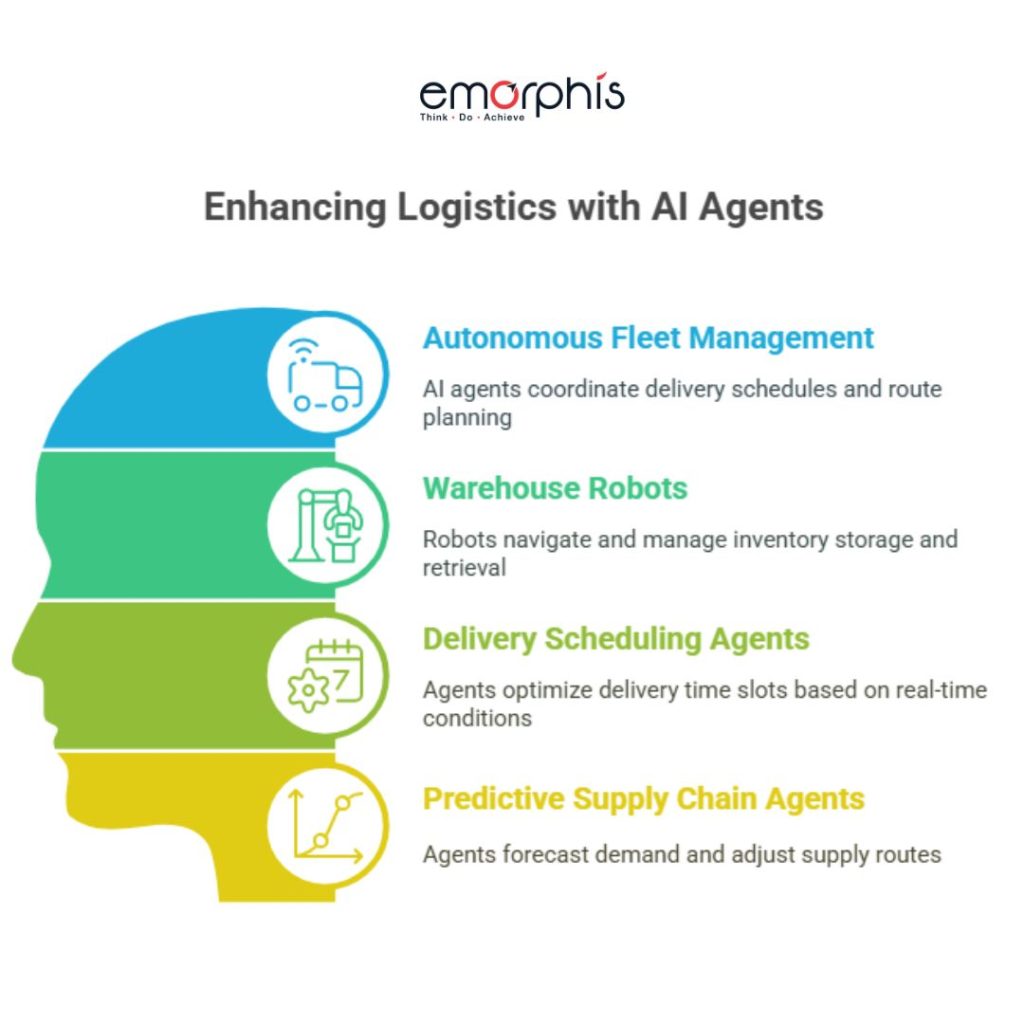
In logistics, AI agent development enables hyper-efficiency and real-time adaptability, critical in today’s fast-paced supply networks.
G. Telecommunications
Telecom companies are using AI agent development to enhance user experiences, manage network operations, and predict service outages.
Use cases include:
- Self-Service Customer Agents: Chatbots that handle bill payments, plan upgrades, and technical support requests.
- Network Monitoring Agents: These agents detect anomalies or potential failures in network traffic and proactively respond.
- Personalized Plan Recommendations: AI agents suggest the best plans to users based on usage history and behavior patterns.

Through AI agent development, telecom providers can reduce churn, improve service quality, and enhance operational resilience.
H. Human Resources and Workforce Management
Organizations are turning to AI agent development to automate recruiting, onboarding, and employee engagement.
Use cases include:
- Recruiting Agents: These agents screen resumes, rank candidates, and schedule interviews, reducing time-to-hire.
- Onboarding Assistants: AI agents guide new employees through processes, training, and document submissions.
- Employee Engagement Bots: Learning agents monitor feedback and engagement scores to suggest interventions or wellness programs.
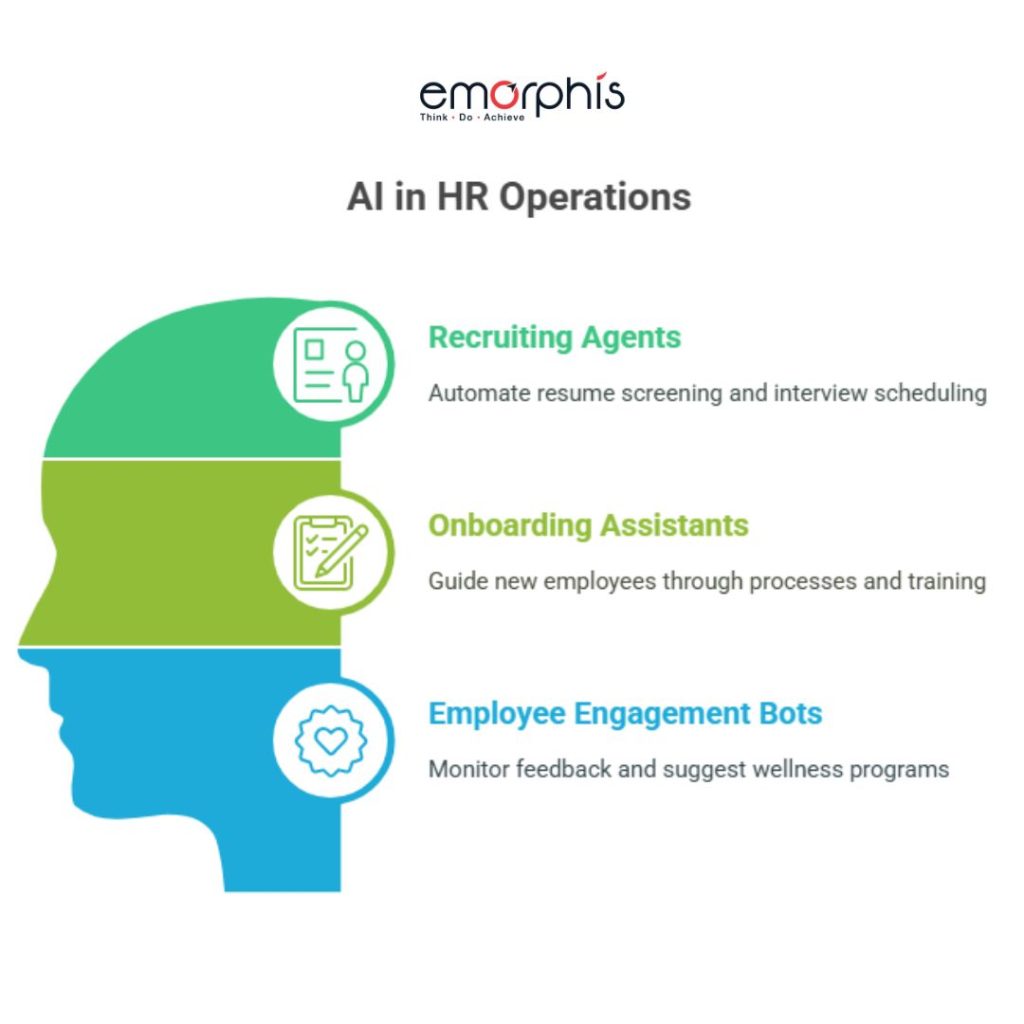
HR departments benefit significantly from AI agent development by streamlining people operations and improving employee experience.
The scope of AI agent development spans nearly every major industry, offering solutions that enhance autonomy, intelligence, and productivity. Whether it’s through reactive agents providing instant feedback or learning agents adapting over time, these use cases highlight how AI agent development is not just a technological innovation; it’s a business transformation tool.
By understanding and applying these real-world use cases, organizations can effectively deploy AI agents to solve pressing challenges, improve services, and gain a competitive edge in their markets.
Further, follow the link to check more details on trending applications of AI across industries.
Agentic AI vs Traditional Automation
Unlike traditional automation, which relies on static rules, agentic AI is dynamic, context-aware, and goal-driven. Traditional bots operate on “if-this-then-that” logic, while AI agent development focuses on building agents capable of:
- Understanding complex contexts
- Making autonomous decisions
- Coordinating with other agents
- Achieving goals even in uncertain environments
This shift from static scripts to dynamic AI agents is one of the most transformative changes in modern AI development.
Tools and Frameworks for AI Agent Development
The rise of AI agent development has led to the creation of powerful tools and frameworks that simplify and accelerate the process of building intelligent, autonomous agents. These platforms provide modular components for memory, reasoning, decision-making, chaining actions, and integrating external tools, all essential functions in modern agent-based systems.
Below is a breakdown of the most prominent frameworks used today in AI agent development:
- LangChain: Build agents using LLMs with memory, tools, and chaining.
- AutoGPT / BabyAGI: Open-source frameworks for autonomous LLM agents.
- CrewAI / Superagent: Multi-agent collaboration and orchestration.
- Haystack / RAG stack: Retrieval-Augmented Generation for knowledge-rich agents.
- OpenAI Function Calling / Toolformer: Integrate LLMs with external tools.
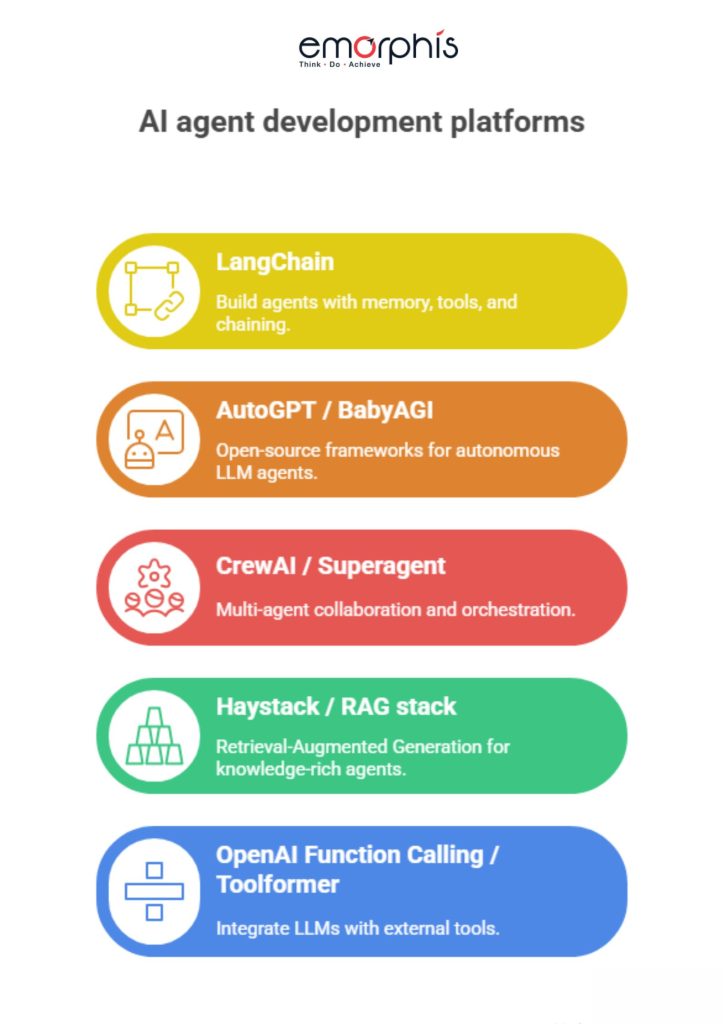
These frameworks simplify the process of AI agent development by offering modular capabilities for reasoning, planning, and tool use.
Best Practices in AI Agent Development
1. Start Small and Iterate
One of the most critical rules in AI agent development is to avoid overengineering in the early stages. Start by building a minimal viable agent that performs a limited number of tasks or solves a very specific problem. This allows you to:
- Validate assumptions and design choices early
- Identify bugs and bottlenecks in a controlled setting
- Collect real-world interaction data for future learning agents
For instance, instead of developing a full-fledged customer support agent on day one, begin with a chatbot that handles FAQs. Once proven, gradually introduce natural language understanding, escalation workflows, and sentiment analysis.
By taking an incremental approach to AI agent development, you reduce complexity, improve agility, and lower the risk of failure.
2. Focus on Goals and Success Metrics
Clearly defining the agent’s purpose is foundational to successful AI agent development. What exactly should the agent achieve? What constitutes success or failure?
Best practices include:
- Defining specific, measurable goals (e.g., reduce call wait times, increase accuracy of diagnosis, optimize delivery routes)
- Aligning agent objectives with broader business or operational KPIs
- Setting up mechanisms to continuously evaluate and benchmark agent performance
In goal-based AI agent development, agents need explicit utility or reward functions that drive their behavior. Without clearly defined goals, agents may produce suboptimal or unintended outcomes.
3. Incorporate Feedback Loops for Learning
To create intelligent and adaptive systems, feedback is vital. Agents must be designed to observe the results of their actions, compare them with expected outcomes, and adjust behavior accordingly. This is especially important for learning agents and systems that operate in dynamic environments.
Best practices in feedback integration include:
- Enabling continuous or episodic learning based on environmental feedback
- Using reinforcement learning or supervised updates from human input
- Logging agent behavior and user responses for retraining models
Incorporating feedback loops in AI agent development ensures that the agent improves over time, adapts to new situations, and maintains long-term relevance.
4. Ensure Explainability and Transparency
One of the growing concerns in AI agent development is the black-box nature of many intelligent systems. For adoption and trust, especially in high-stakes industries like healthcare, finance, or law, agents must be explainable.
To achieve explainability:
- Use interpretable models where feasible (e.g., decision trees, rule-based logic)
- Integrate natural language explanations of agent behavior or decisions
- Log and display reasoning paths or confidence scores for each action
Explainability is essential not just for end-users but also for developers, regulators, and business stakeholders. It ensures compliance, trust, and ethical alignment in AI agent development initiatives.
5. Design for Collaboration and Integration
Rarely do AI agents operate in isolation. Effective AI agent development should include the ability for agents to interact with humans, other agents, and external systems. This is especially important in enterprise settings or complex environments like supply chains, hospitals, and smart cities.
Best practices for collaboration include:
- Enabling multi-agent coordination using agent communication languages (ACLs)
- Designing APIs and connectors for easy integration with third-party systems
- Providing human override and intervention mechanisms for critical decisions
By building agents that collaborate, share context, and delegate tasks, you enable robust and flexible workflows. Collaboration is a hallmark of advanced AI agent development strategies that aim to augment rather than replace human capabilities.
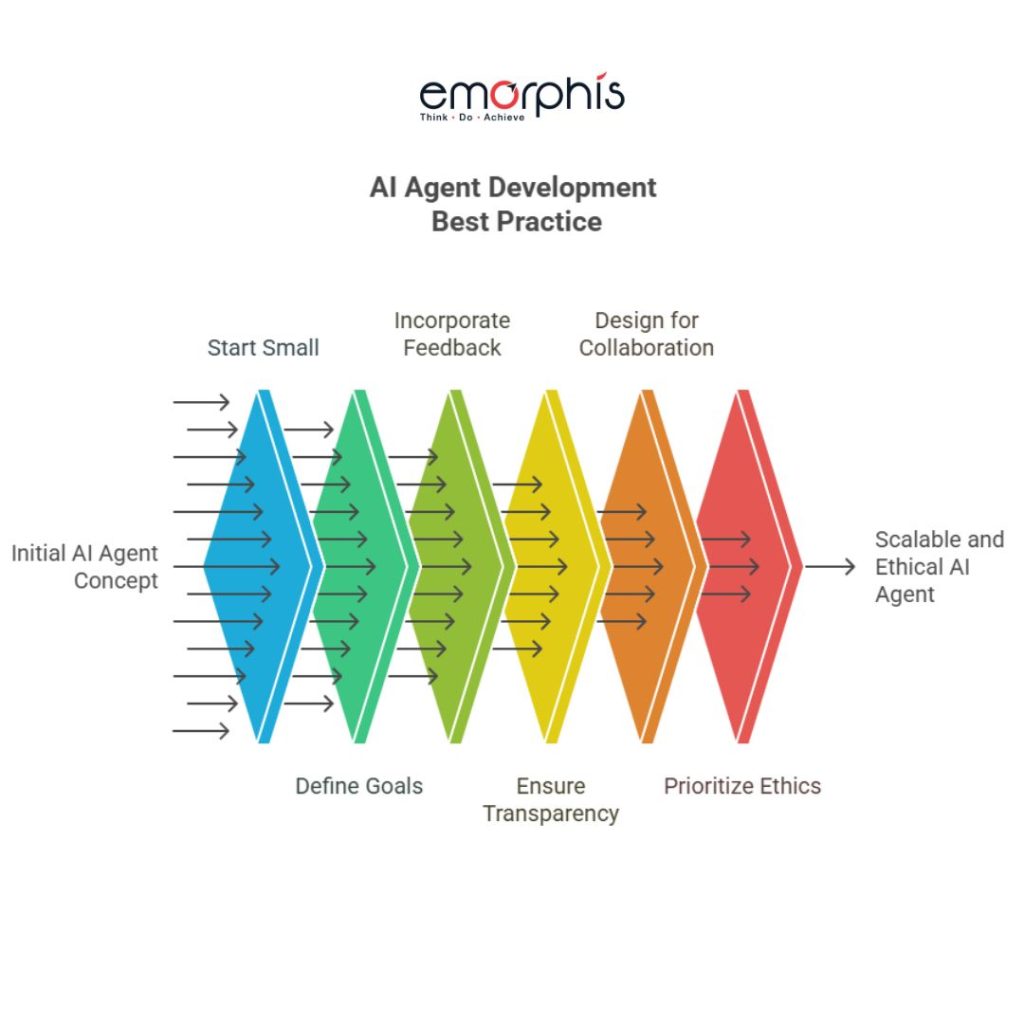
6. Prioritize Ethics and Safety
As agents become more autonomous, the responsibility to ensure ethical behavior and safety grows. This is especially true in areas involving sensitive data, human lives, or financial assets.
Best practices include:
- Avoiding bias by using diverse, representative training datasets
- Setting constraints on agent behavior to prevent harmful actions
- Monitoring performance to detect and correct anomalies or drift
- Ensuring compliance with relevant regulations like GDPR or HIPAA
Ethical considerations in AI agent development aren’t just moral imperatives; they’re essential for trust, adoption, and legal compliance.
7. Test Extensively in Simulated and Real Environments
Before deploying an agent into production, it’s critical to test how it performs under various conditions. Simulated environments allow for rapid iteration, stress testing, and behavior validation without real-world consequences.
Best practices include:
- Using agent simulation tools to evaluate different scenarios
- Performing A/B tests against baseline systems
- Testing edge cases and failure modes proactively
By testing rigorously, AI agent development teams can fine-tune agents for robustness, resilience, and safety under unpredictable conditions.
8. Design for Scalability and Maintenance
Long-term success in AI agent development requires thinking beyond deployment. How easily can your agent scale? How will it be updated? Who maintains the system?
To ensure scalability:
- Use modular architectures and microservices for deployment
- Enable centralized monitoring and version control
- Design agents to be retrainable or reconfigurable without full redevelopment
As organizations expand the use of AI agents, these practices help avoid technical debt and ensure maintainability at scale.
Cost of AI Agent Development
The cost of AI agent development can vary widely depending on the complexity, functionality, and scale of the agent being built. Basic AI agents with limited task automation or rule-based behavior can cost between $10,000 to $25,000, while more advanced agents, such as those powered by large language models (LLMs), capable of reasoning, learning, and interacting across multiple systems, can range from $50,000 to $200,000 or more.
Factors influencing the cost include data integration requirements, model training needs, API or tool usage (e.g., OpenAI, LangChain, vector databases), user interface design, testing environments, and deployment scalability.
In enterprise settings, long-term support, security compliance, and multi-agent orchestration may further raise development and maintenance expenses. Despite the investment, AI agents often deliver a high return on investment by significantly reducing operational costs and enabling continuous automation.
The Future of AI Agent Development
Looking ahead, AI agent development is poised to revolutionize how we build and interact with intelligent systems. As technologies mature and use cases grow, agents will become more autonomous, adaptive, and deeply integrated into our daily lives and industries. Here are key trends shaping the future of this space:

I. Multi-Agent Ecosystems
The future will see the rise of multi-agent systems where swarms of AI agents operate collaboratively across distributed environments. These agents will communicate, negotiate, and delegate tasks among themselves to solve complex problems, such as coordinating traffic, managing supply chains, or automating entire business processes, without centralized control.
ii. Human-Agent Co-pilots
We are entering the age of human-agent collaboration, where AI agents act as co-pilots to enhance human decision-making. Whether it’s helping doctors analyze medical imaging, assisting marketers with campaign creation, or supporting engineers in code generation, these agents will work alongside humans in real time, improving productivity and creativity.
iii. Agent Marketplaces
Shortly, we can expect AI agent marketplaces—platforms where users can browse, purchase, or deploy pre-trained agents with specific capabilities (e.g., scheduling, summarizing, analyzing data). These plug-and-play agents will be modular, interoperable, and customizable, enabling rapid deployment without starting from scratch.
iv. Embedded Edge Agents
With the growth of IoT and robotics, embedded edge agents will become commonplace. These on-device AI agents will function independently of cloud infrastructure, enabling low-latency, offline decision-making in smart homes, wearables, autonomous vehicles, drones, and industrial robots.
v. Smarter, Autonomous Systems
As generative AI, reinforcement learning, and agent simulation environments continue to evolve, AI agents will gain advanced reasoning, self-learning, and problem-solving abilities. Future agents will be capable of not only understanding natural language and multimodal input but also planning long-term strategies and adapting to dynamic environments without human intervention.
AI agent development is moving from task-specific automation to the creation of general-purpose, intelligent, and autonomous ecosystems. This next phase promises more scalable, resilient, and human-aligned systems that redefine how work and decision-making happen across industries.

Final Thoughts
AI agent development is no longer a futuristic concept; it’s a practical, deployable technology that is reshaping industries and experiences. Whether you’re building a smart assistant, an enterprise automation tool, or a multi-agent system, the key lies in understanding the agent architecture, selecting the right tools, and following best practices.
Build an AI Agent now, connect with an AI Development Company.
As the field continues to evolve, staying updated with the latest frameworks, ethical considerations, and use cases is vital. Embracing AI agent development today will position your organization at the forefront of intelligent automation tomorrow.



